Unit 4 Don't eat in class. Section A Grammar Focus-3c课件 (共27张PPT)
文档属性
| 名称 | Unit 4 Don't eat in class. Section A Grammar Focus-3c课件 (共27张PPT) |  | |
| 格式 | ppt | ||
| 文件大小 | 5.1MB | ||
| 资源类型 | 教案 | ||
| 版本资源 | 人教新目标(Go for it)版 | ||
| 科目 | 英语 | ||
| 更新时间 | 2022-03-22 14:04:27 | ||
图片预览


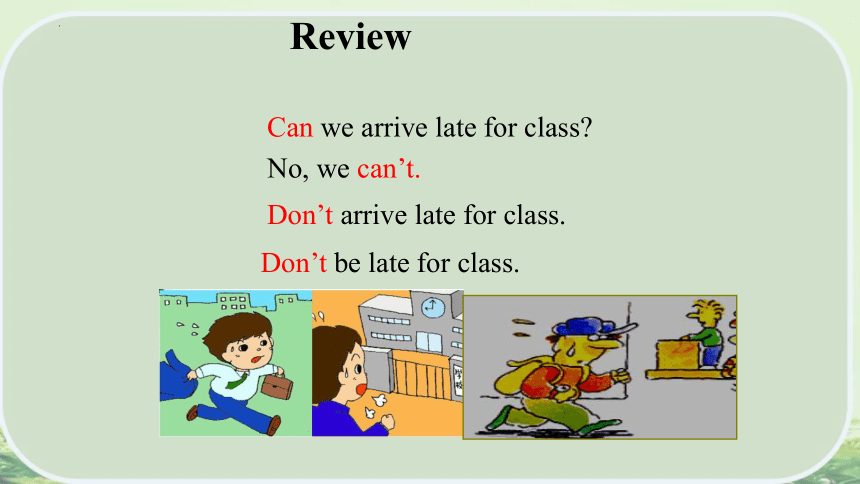


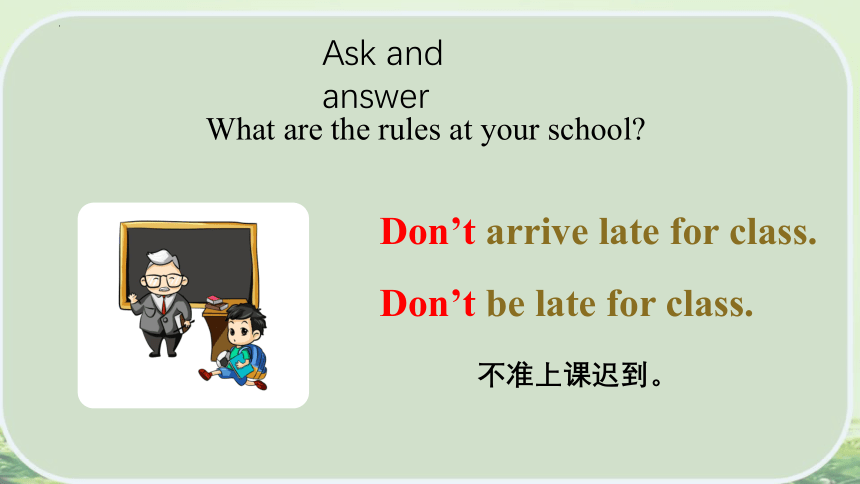
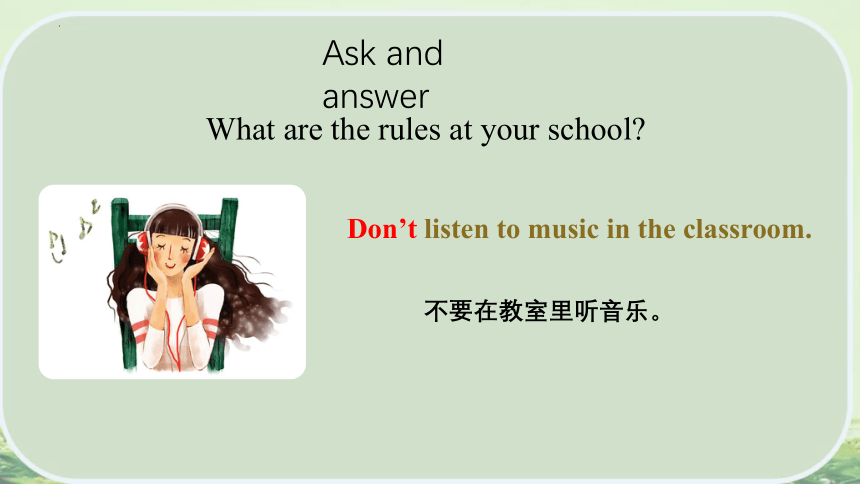
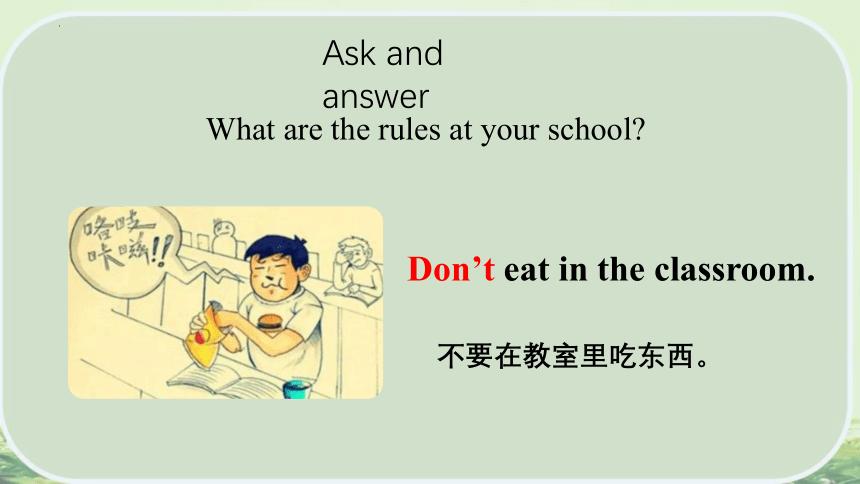
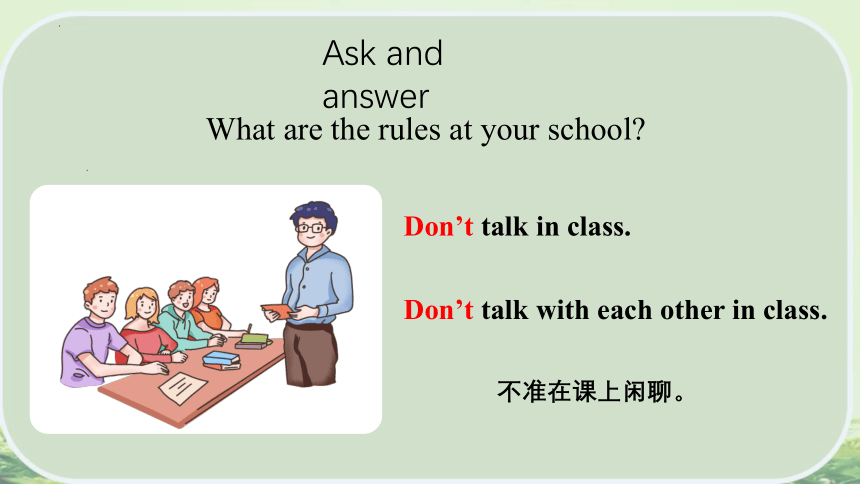
文档简介
(共27张PPT)
Unit 4 Don't eat in class.
Section A GF -3c
能够熟练地运用祈使句、情态动词can、must及have to表达规章制度。 能通过观察并归纳总结出相应的语法知识项目。 能正确运用目标语言谈论和制定学校或家庭规则。
学 习 目 标
1
2
3
德 育 目 标
遵守规则,养成自律的好习惯。
Review
Can we arrive late for class
Don’t arrive late for class.
Don’t be late for class.
No, we can’t.
Don’t eat in the class.
Can we eat in the class
No, we can’t.
You can eat in the dinning room.
Yes, we do.
Do you have to do homework after class
We have to do homework after class.
Do you have to do some reading every day
Yes, we do.
We have to do some reading every day.
What are the rules at your school
Ask and answer
Don’t arrive late for class.
不准上课迟到。
Don’t be late for class.
Don’t listen to music in the classroom.
不要在教室里听音乐。
What are the rules at your school
Ask and answer
不要在教室里吃东西。
Don’t eat in the classroom.
What are the rules at your school
Ask and answer
What are the rules at your school
Ask and answer
Don’t talk in class.
Don’t talk with each other in class.
不准在课上闲聊。
Don’t run in the hallways. Don’t fight.
What are the rules We must be on time for class.
Can we eat in the classroom No, we can’t, but we can eat in the dining hall.
Can we wear a hat in class Yes, we can./No, we can’t.
Does he have to wear a uniform at school Yes, he does./No, he doesn’t.
What do you have to do We have to be quiet in the library.
4. 祈使句的肯定句和否定句是怎样构成的?一般什么情况下使用祈使句?
1. 圈出情态动词, 观察它们在用法上有什么共同点?
3. can在本单元主要表示什么含义?它还可以表达什么意思?
2. have to在句法上和其他情态动词的区别在哪里
Grammar
Focus
情态动词+动原
Pause1’
1. 祈使句是用来表示请求、命令或建议等的一种句型。
2. 其主语一般为第二人称you,但通常省略。
3. 句中谓语动词用动词原形。
4. 祈使句的句末一般用句号,表示较强语气时用感叹号。为了使祈使句显得更委婉、有礼貌,可在开头或结尾加上please。
Language points
祈使句
句式结构 肯定式 否定式
P型:Please+动词原形+其他 Please stand up. Please don’t stand up.
V 型:动词原形+其他 Sit down./ Stand up. Don’t talk in class.
L型:Let +宾语+动词原形+其他 Let me help you. Don’t let her go./
Let him not go.
B 型:Be+表语 Be carful!
Be a good boy. Don’t be late for class.
Don’t be silly.
N型:No+名词/动名词 \ No SMOKING!
NO FISHING!
5. 祈使句的句式结构
情态动词can与have to
情态动词can的用法
①can意为“能;会”,表示做某事的能力,其否定式为can't。
eg:Can you speak English?你会讲英语吗?
②表示“允许;许可”。
eg:You can't eat in class.你不能在课堂上吃东西。
情态动词have to的用法
have to意为“必须;不得不”,其后接动词原形。have to有第三人称单数形式,即has to,变疑问句和否定句要借助动词do/does。
eg:We have to go home after school.我们放学后必须回家。
1.No talking.
3. No music.
4.No photos.
Library Rules
1._____________
2._____________
3._____________
4._____________
Don’t talk.
Don’t eat.
Don’t listen to music.
Don’t take photos.
3a
Write the rules for the school library.
Pause1’
1.No talking.
3. No music.
Do you know these signs
警示语:
No+n. / v.-ing = Don’t do
No Swimming
No Parking
No Smoking
Use the words to make questions about the rules.
Be quiet
Q: Does she have to be quiet in the library
(she/have to/in the library)
A: Yes,she does.
Eat
Q:______________________________________
(he/have to/in the dining hall)
A:__________________
Does he have to eat in the dining hall
Yes, he does.
3b
Pause2’
Listen to music
Q:______________________________________________________
(we/can/in the hallways)
A:__________________
Wear a hat
Q:______________________________________________________
(we/can/in the classroom)
A:__________________
Can we listen to music in the hallways
No, we can’t.
Can we wear a hat in the classroom
No, we can’t.
Make up five cool rules for your dream school. Share your rules with
the class. Your classmates vote for the Coolest School!
3c
At my dream school, we don’t have to come to school every day.
We can eat in class.
We don’t have to wear school uniforms.
We can listen to music in class.
Make up five cool rules for your dream school. Share your rules with
the class. Your classmates vote for the Coolest School!
3c
We can eat in the classroom.
We don’t have to do homework.
Make up five cool rules for your dream school. Share your rules with
the class. Your classmates vote for the Coolest School!
3c
At my dream school, we don’t have to come to school every day. We can eat in the classroom. We can listen to music in class. We don’t have to do homework. We don’t have to wear the school uniform at school.
Summary
①an important rule
①. Don’t …
②. can’t…
③. have to…
④. must…
⑤. can…
②wear the school uniform
③bring … to…
④be quiet
一、单项选择。
1. _____ listen to music in the classroom.
A. Not B. No C. Don't D. Doesn't
2. Tom, please _____ the classroom now.
A. clean B. to clean C. cleans D. cleaning
3. Let's _____ on time for classes.
A. be B. be not C. are D. is
4. She has to _____ her homework every night.
A. does B. do C. doing D. did
5. Sorry, you _____ play basketball in the classroom.
A. can't B. don't C. don't have to D. doesn't
C
A
A
B
A
Exercise
二、用括号内所给单词的适当形式填空。
6. (not play) with fire (火).
7. Don't (run) in the classroom.
8. Let him (not play) basketball.
9. Can we (eat) here
10. Do you have to (wear) the school uniform at school
Don't play
run
not play
eat
wear
三、按要求完成句子。
11. Lily can play the guitar.(改为一般疑问句并作否定回答)
Lily the guitar
,she .
12. Jack has to play the piano every weekend.(改为一般疑问句)
Jack play the piano every weekend
13. Be quick.(改为否定句)
________________
14. You can't eat food in class.(改为祈使句)
_________________________
15. You must walk to school today.(改为祈使句)
__________________________
16. You can't be late for class next time.(改为祈使句)
___________________________________
Can
play
No
can't
Does
have
to
Don't be quick.
Don't eat food in class.
Walk to school today.
Don't be late for class next time.
1. Recite the sentence patterns in Grammar Focus.
2. Finish the exercises of Section A .
Unit 4 Don't eat in class.
Section A GF -3c
能够熟练地运用祈使句、情态动词can、must及have to表达规章制度。 能通过观察并归纳总结出相应的语法知识项目。 能正确运用目标语言谈论和制定学校或家庭规则。
学 习 目 标
1
2
3
德 育 目 标
遵守规则,养成自律的好习惯。
Review
Can we arrive late for class
Don’t arrive late for class.
Don’t be late for class.
No, we can’t.
Don’t eat in the class.
Can we eat in the class
No, we can’t.
You can eat in the dinning room.
Yes, we do.
Do you have to do homework after class
We have to do homework after class.
Do you have to do some reading every day
Yes, we do.
We have to do some reading every day.
What are the rules at your school
Ask and answer
Don’t arrive late for class.
不准上课迟到。
Don’t be late for class.
Don’t listen to music in the classroom.
不要在教室里听音乐。
What are the rules at your school
Ask and answer
不要在教室里吃东西。
Don’t eat in the classroom.
What are the rules at your school
Ask and answer
What are the rules at your school
Ask and answer
Don’t talk in class.
Don’t talk with each other in class.
不准在课上闲聊。
Don’t run in the hallways. Don’t fight.
What are the rules We must be on time for class.
Can we eat in the classroom No, we can’t, but we can eat in the dining hall.
Can we wear a hat in class Yes, we can./No, we can’t.
Does he have to wear a uniform at school Yes, he does./No, he doesn’t.
What do you have to do We have to be quiet in the library.
4. 祈使句的肯定句和否定句是怎样构成的?一般什么情况下使用祈使句?
1. 圈出情态动词, 观察它们在用法上有什么共同点?
3. can在本单元主要表示什么含义?它还可以表达什么意思?
2. have to在句法上和其他情态动词的区别在哪里
Grammar
Focus
情态动词+动原
Pause1’
1. 祈使句是用来表示请求、命令或建议等的一种句型。
2. 其主语一般为第二人称you,但通常省略。
3. 句中谓语动词用动词原形。
4. 祈使句的句末一般用句号,表示较强语气时用感叹号。为了使祈使句显得更委婉、有礼貌,可在开头或结尾加上please。
Language points
祈使句
句式结构 肯定式 否定式
P型:Please+动词原形+其他 Please stand up. Please don’t stand up.
V 型:动词原形+其他 Sit down./ Stand up. Don’t talk in class.
L型:Let +宾语+动词原形+其他 Let me help you. Don’t let her go./
Let him not go.
B 型:Be+表语 Be carful!
Be a good boy. Don’t be late for class.
Don’t be silly.
N型:No+名词/动名词 \ No SMOKING!
NO FISHING!
5. 祈使句的句式结构
情态动词can与have to
情态动词can的用法
①can意为“能;会”,表示做某事的能力,其否定式为can't。
eg:Can you speak English?你会讲英语吗?
②表示“允许;许可”。
eg:You can't eat in class.你不能在课堂上吃东西。
情态动词have to的用法
have to意为“必须;不得不”,其后接动词原形。have to有第三人称单数形式,即has to,变疑问句和否定句要借助动词do/does。
eg:We have to go home after school.我们放学后必须回家。
1.No talking.
3. No music.
4.No photos.
Library Rules
1._____________
2._____________
3._____________
4._____________
Don’t talk.
Don’t eat.
Don’t listen to music.
Don’t take photos.
3a
Write the rules for the school library.
Pause1’
1.No talking.
3. No music.
Do you know these signs
警示语:
No+n. / v.-ing = Don’t do
No Swimming
No Parking
No Smoking
Use the words to make questions about the rules.
Be quiet
Q: Does she have to be quiet in the library
(she/have to/in the library)
A: Yes,she does.
Eat
Q:______________________________________
(he/have to/in the dining hall)
A:__________________
Does he have to eat in the dining hall
Yes, he does.
3b
Pause2’
Listen to music
Q:______________________________________________________
(we/can/in the hallways)
A:__________________
Wear a hat
Q:______________________________________________________
(we/can/in the classroom)
A:__________________
Can we listen to music in the hallways
No, we can’t.
Can we wear a hat in the classroom
No, we can’t.
Make up five cool rules for your dream school. Share your rules with
the class. Your classmates vote for the Coolest School!
3c
At my dream school, we don’t have to come to school every day.
We can eat in class.
We don’t have to wear school uniforms.
We can listen to music in class.
Make up five cool rules for your dream school. Share your rules with
the class. Your classmates vote for the Coolest School!
3c
We can eat in the classroom.
We don’t have to do homework.
Make up five cool rules for your dream school. Share your rules with
the class. Your classmates vote for the Coolest School!
3c
At my dream school, we don’t have to come to school every day. We can eat in the classroom. We can listen to music in class. We don’t have to do homework. We don’t have to wear the school uniform at school.
Summary
①an important rule
①. Don’t …
②. can’t…
③. have to…
④. must…
⑤. can…
②wear the school uniform
③bring … to…
④be quiet
一、单项选择。
1. _____ listen to music in the classroom.
A. Not B. No C. Don't D. Doesn't
2. Tom, please _____ the classroom now.
A. clean B. to clean C. cleans D. cleaning
3. Let's _____ on time for classes.
A. be B. be not C. are D. is
4. She has to _____ her homework every night.
A. does B. do C. doing D. did
5. Sorry, you _____ play basketball in the classroom.
A. can't B. don't C. don't have to D. doesn't
C
A
A
B
A
Exercise
二、用括号内所给单词的适当形式填空。
6. (not play) with fire (火).
7. Don't (run) in the classroom.
8. Let him (not play) basketball.
9. Can we (eat) here
10. Do you have to (wear) the school uniform at school
Don't play
run
not play
eat
wear
三、按要求完成句子。
11. Lily can play the guitar.(改为一般疑问句并作否定回答)
Lily the guitar
,she .
12. Jack has to play the piano every weekend.(改为一般疑问句)
Jack play the piano every weekend
13. Be quick.(改为否定句)
________________
14. You can't eat food in class.(改为祈使句)
_________________________
15. You must walk to school today.(改为祈使句)
__________________________
16. You can't be late for class next time.(改为祈使句)
___________________________________
Can
play
No
can't
Does
have
to
Don't be quick.
Don't eat food in class.
Walk to school today.
Don't be late for class next time.
1. Recite the sentence patterns in Grammar Focus.
2. Finish the exercises of Section A .
同课章节目录
- Unit 1 Can you play the guitar?
- Section A
- Section B
- Unit 2 What time do you go to school?
- Section A
- Section B
- Unit 3 How do you get to school?
- Section A
- Section B
- Unit 4 Don't eat in class.
- Section A
- Section B
- Unit 5 Why do you like pandas?
- Section A
- Section B
- Unit 6 I'm watching TV.
- Section A
- Section B
- Review of Units 1-6
- Unit 7 It's raining!
- Section A
- Section B
- Unit 8 Is there a post office near here?
- Section A
- Section B
- Unit 9 What does he look like?
- Section A
- Section B
- Unit 10 I'd like some noodles.
- Section A
- Section B
- Unit 11 How was your school trip?
- Section A
- Section B
- Unit 12 What did you do last weekend?
- Section A
- Section B
